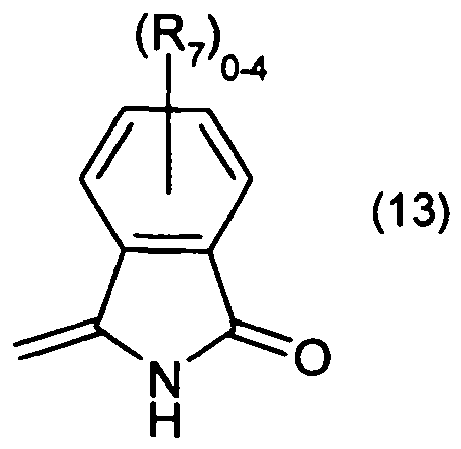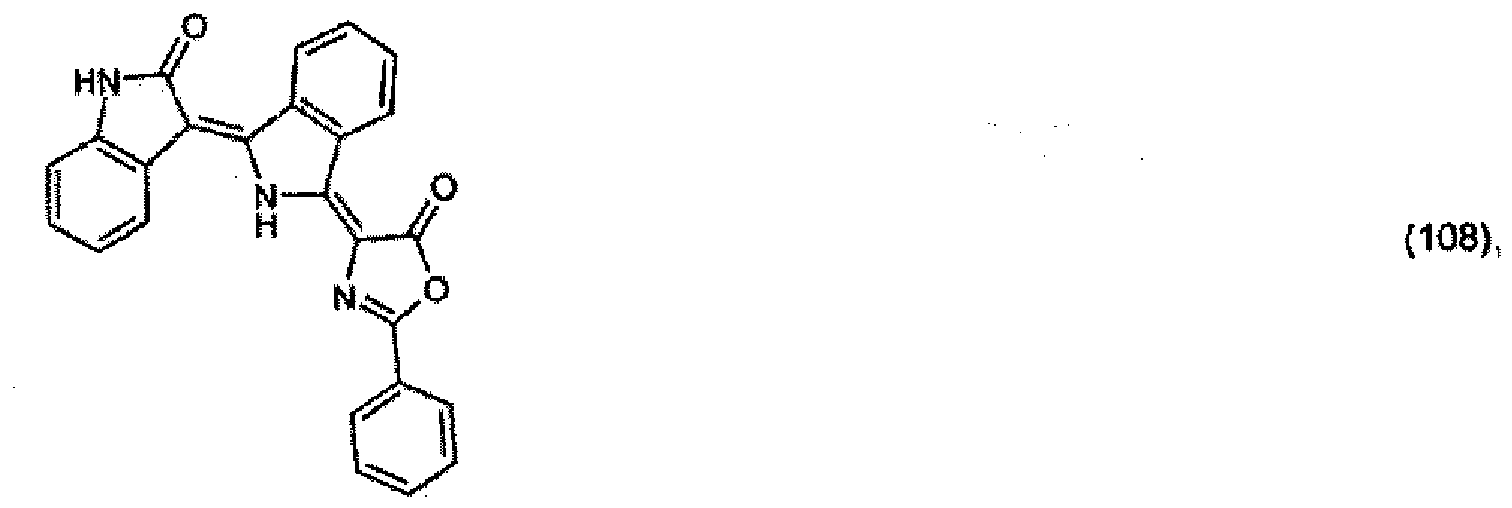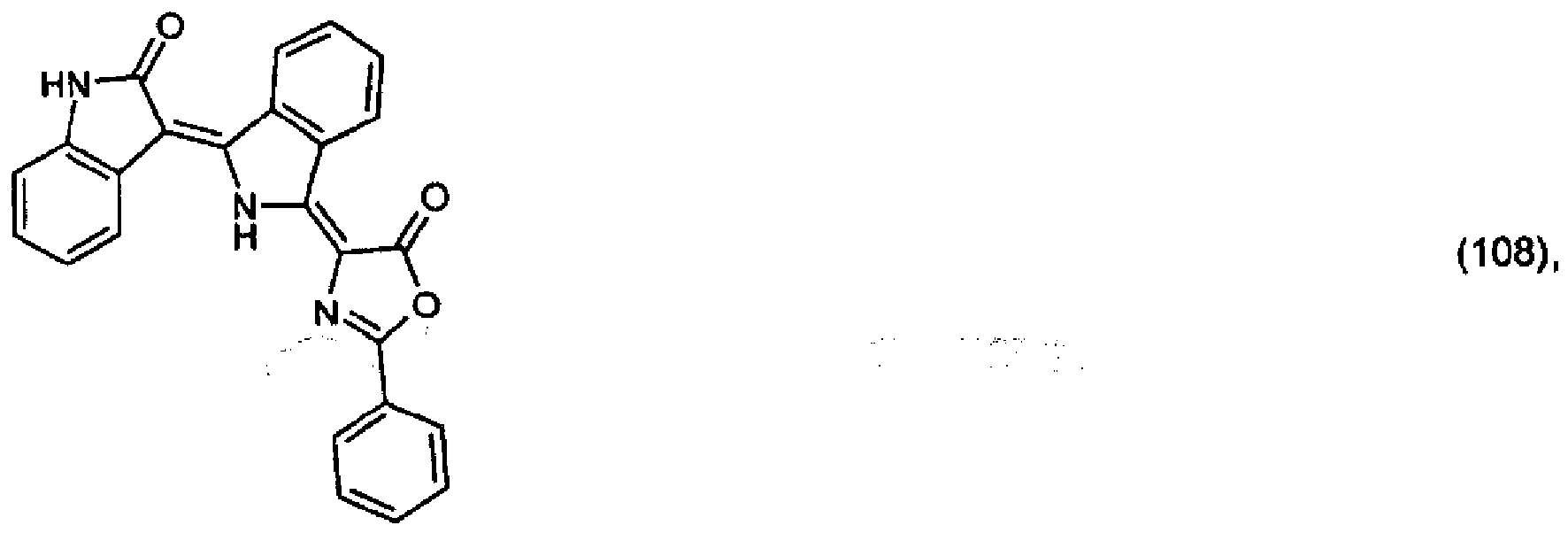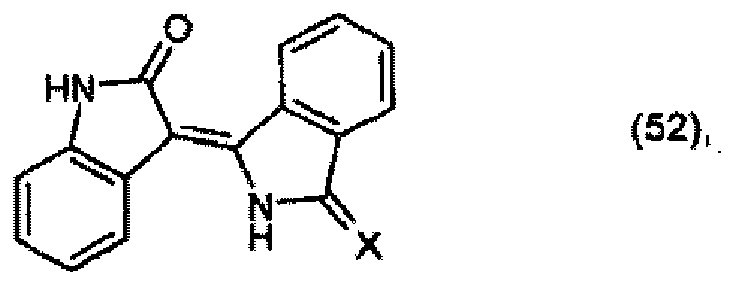|
(11) | EP 1 476 505 B1 |
| (12) | EUROPEAN PATENT SPECIFICATION |
|
|
| (54) |
LACTAM-BASED PIGMENTS AND THE USE THEREOF IN THE PRODUCTION OF COLOURED PLASTICS OR POLYMERIC COLOUR PARTICLES PIGMENTE AUF BASIS VON LACTAM UND DEREN VERWENDUNG IN DER HERSTELLUNG GEFÄRBTER KUNSTSTOFFE ODER POLYMERER FARBPARTIKEL PIGMENTS A BASE DE LACTAME ET LEUR UTILISATION DANS LA PRODUCTION DE PLASTIQUES COLORES OU DE PARTICULES COLOREES POLYMERES |
|
|
|||||||||||||||||||||||||||
| Note: Within nine months from the publication of the mention of the grant of the European patent, any person may give notice to the European Patent Office of opposition to the European patent granted. Notice of opposition shall be filed in a written reasoned statement. It shall not be deemed to have been filed until the opposition fee has been paid. (Art. 99(1) European Patent Convention). |
[0001] The present invention relates to novel lactam-based pigments, to a process for the preparation of those pigments, and to their use in the production of coloured plastics or polymeric colour particles.
[0002] Methods for colouring synthetic materials, such as plastics and polymeric colour particles, in the mass, using pigments, are known.
[0003] CH-A-676846 describes a process for synthesis of hydantoin derivatives, wherein the carbon atom at the 5-position forms with the adjacent carbon atom of the substituent an exocyclic double bond. Said hydantoin derivatives are obtained by reaction of a dialkyl hydantoin-5-yl phosphonate with an aldehyde and are useful as intermediates for anthithrombotic substances.
[0004] Journal of heterocyclic chemistry, 1989, vol. 26, no. 3, pages 821-8 describes the reaction of 2-chloro-3H-indol-3-one or isatine with nucleophiles, wherein inter alia 3-oxo-indol-2-ylidene or 2-oxo-indol-3-ylidene derivatives are obtained.
[0005] EP-A-0003565 describes (1H-benzoimidazol-2-yl)-(1-alkyl-2-oxo-1,2-diyhdro-indol-3-ylidene)-acetonitrile derivatives as disperse dyes for synthetic fibres. They are obtained by condensation of N-alkyl-isatinic derivatives with benzoimidazol-2-yl-acetonitrile.
[0006] DE-A-2438414 describes dispersing agents, which are obtained by reaction of a diisocyanate, a polymer containing a hydroxyl group and an organic substance containing two functional groups, which react with an isocyanate. Said organic substance can be inter alia the pigment 1-ethyl-3-(3-oxo-isoindoline-1-ylidene)-2-oxo-indoline.
[0007] Chemical and pharmaceutical bulletin, 1977, vol. 25, no. 11, pages 3087-9 describes inter alia (benzimidazol-2-yl)-(1,2-dihydro-2-oxo-3H-indol-3-ylidene)-acetonitrile, which is obtained by the reaction of benzoimidazol-2-yl-acetonitrile with isatin.
[0008] EP-A-0632102 describes dyes for mass dyeing of plastics. These dyes are inter alia 1,2-dihydro-2-oxo-3-H-indol-3-ylidene derivatives, which can be obtained by condensation reaction of oxindole and aromatic aldehydes.
[0009] It has been found, however, that the pigments used in such a method do not always fully meet the highest demands, especially with respect to fastness to light, thermal stability and/or tinctorial strength; nor do they completely cover the entire palette of shades desired. There is accordingly a need for new pigments that yield light-fast, thermally stable and tinctorially strong colorations, especially in the yellow to red colour range, and that exhibit good general fastness properties.
[0010] It has now been found, surprisingly, that the pigments according to the invention substantially meet the above criteria.
[0011] The present invention accordingly relates to a method of producing coloured plastics or polymeric colour particles, which comprises mixing a high molecular weight organic material and a tinctorially effective amount of at least one pigment with one another, wherein the pigment is of formula
wherein
R1 is hydrogen or C1-C12alkyl,
R2 is hydrogen, -CN, -COO-aryl, -COO-heteroaryl, -CONH-aryl or -CONH-heteroaryl, and
R3 is the radical of a heteroaromatic compound of formula
or
or
R2 and R3 together form a radical of formula
or
wherein
R4 and R5 are each independently of the other -CN, -COO-aryl, -COO-heteroaryl, -CONH-aryl or -CONH-heteroaryl,
R6 is a radical of formula
R7 is halogen, and
R8 and R9 are each independently of the other C1-C4alkyl.
[0012] R1 as C1-C12alkyl is, for example, methyl, ethyl, propyl, isopropyl, n-butyl, isobutyl, sec-butyl, tert-butyl, pentyl, hexyl, heptyl, octyl, nonyl, decyl, undecyl or dodecyl.
[0013] Aryl in -COO-aryl and -CONH-aryl in R2, R4 and R5 is each independently of any other, for example, phenyl which is unsubstituted or substituted by methyl or by halogen, especially by chlorine.
[0014] Heteroaryl in -CONH-heteroaryl and -COO-heteroaryl in R2, R4 and R5 is each independently of any other, for example, pyrrole, furan, thiophene, pyridine, imidazole, thiazole, piperazine or pyrimidine.
[0020] R8 and R9 as C1-C4alkyl are each independently of the other methyl, ethyl, propyl, isopropyl, n-butyl, isobutyl, sec-butyl or, especially, tert-butyl.
[0022] Preparation of pigments of formula (1) according to the invention is carried out, for example, by reacting a compound of formula
with a compound of formula
wherein
X is =NH or =O, to form a compound of formula
and optionally, when X is =NH, further reacting the compound of formula (52) with an active-methylene compound, for example of formula R4 - CH2 - R5.
[0023] The present invention relates also to a method of producing coloured plastics or polymeric colour particles, which comprises mixing a high molecular weight organic material and a tinctorially effective amount of at least one pigment of formula (1) with one another.
[0024] The colouring of high molecular weight organic substances with the pigment of formula (1) is carried out, for example, by admixing such a pigment with the substrates using roll mills or mixing or grinding apparatuses, as a result of which the pigment is dissolved or finely dispersed in the high molecular weight material. The high molecular weight organic material together with the admixed pigment is then processed using methods known per se such as, for example, calendering, compression moulding, extrusion, coating, spinning, pouring or injection moulding, as a result of which the coloured material obtains its final form. Admixture of the pigment can also be effected immediately prior to the actual processing step, for example by continuously and simultaneously feeding a solid pigment, for example in powder form, and a granulated or pulverulent, high molecular weight organic material and, optionally, also additional ingredients, such as, for example, additives, directly into the intake zone of an extruder wherein mixing occurs just before processing. Generally, however, it is preferable to mix the pigment into the high molecular weight organic material beforehand, since more uniformly coloured products can be obtained.
[0025] In order to produce non-rigid shaped articles or to reduce their brittleness, it is frequently desirable to add so-called plasticisers to the high molecular weight compounds prior to shaping. There may be used as plasticisers, for example, esters of phosphoric acid, phthalic acid or sebacic acid. In the method according to the invention, the plasticisers can be incorporated into the polymers before or after incorporation of the colorant. It is furthermore possible, in order to achieve different colour shades, also to add to the high molecular weight organic substances, in addition to the pigment of formula (1), further pigments or other colorants in any amounts, optionally together with further additives such as, for example, fillers or siccatives.
[0026] Preference is given to the colouring of thermoplastic plastics, especially in the form of fibres. Preferred high molecular weight organic materials that can be coloured in accordance with the invention are very generally polymers having a dielectric constant ≥ 2.5, especially polyester, polycarbonate (PC), polystyrene (PS), polymethyl methacrylate (PMMA), polyamide, polyethylene, polypropylene, styrene/acrylonitrile (SAN) and acrylonitrile/butadiene/styrene (ABS). Especially preferred are polyester and polyamide. More especially preferred are linear aromatic polyesters, which can be obtained by polycondensation of terephthalic acid and glycols, especially ethylene glycol, or condensation products of terephthalic acid and 1,4-bis(hydroxymethyl)cyclohexane, such as, for example, polyethylene terephthalate (PET) or polybutylene terephthalate (PBTP), and also polycarbonates, for example those obtained from α,α-dimethyl-4,4-dihydroxydiphenylmethane and phosgene, or polymers based on polyvinyl chloride and on polyamide such as, for example, polyamide 6 or polyamide 6.6.
[0027] The pigments according to the invention impart tinctorially strong shades to the above-mentioned materials, especially the polyester and polyamide materials, with very good in-use fastness properties, these especially being good light-fastness and good thermal stability.
[0028] The Examples that follow serve to illustrate the invention. Unless otherwise specified, parts therein are parts by weight and percentages are percentages by weight. The temperatures are given in degrees Celsius. The relationship between parts by weight and parts by volume is the same as that between grams and cubic centimetres.
Example 1:
[0029] 10.2 parts of 2-indolinone are heated to 90° together with 14.3 parts of 3-iminoisoindolinone hydrochloride and 7.7 parts of potassium acetate in 100 parts of dioxane and 20 parts of glacial acetic acid and stirred at 90° for a further 4 hours. The reaction product that precipitates out is filtered off with suction and is washed with a 5:1 mixture of dioxane and glacial acetic acid and then water. After drying, 14.1 parts of the pigment of formula
are obtained, which colours polyester in the mass in yellow shades, with very good thermal stability and light-fastness.
Example 2:
[0030] 4.4 parts of 2-cyanobenzamide are heated to 175° together with 4.1 parts of 2-indolinone in 25 parts of o-dichlorobenzene and stirred at that temperature for a further 6 hours. After cooling, 4.4 parts of the pigment of formula (100) precipitate out.
Example 3:
[0031] 13.3 parts of 2-indolinone are dissolved in 300 parts of N,N-dimethylacetamide at room temperature and the resulting solution is added to a solution of 14.5 parts of diiminoisoindoline in 150 parts of N,N-dimethylacetamide at room temperature. On being left to stand for 48 hours and dilution with water, 25 parts of the pigment of formula
precipitate out.
[0032] 1 part of the resulting product is stirred under reflux in 50 parts of 85 % acetic acid for 4 hours. After cooling, filtration and drying, 0.5 part of the pigment of formula (100) is isolated.
Example 4:
[0033] 2.6 parts of the pigment of formula (101) prepared in Example 3 are stirred in a mixture of 70 parts of 98 % acetic acid and 10 parts of dimethylacetamide. After addition of 2 parts of dimedone, the reaction mixture is heated to 80° and is stirred at that temperature for a further 12 hours. After dilution with methanol, 2.7 parts of the pigment of formula
precipitate out, which colours polyester in the mass in red shades.
Examples 5-11:
[0034] By replacing the 2.7 parts of dimedone in Example 4 with an equivalent amount of the active-methylene compound indicated in column 2 of Table 1 and proceeding as indicated in Example 4, pigments having the shades indicated in column 4 are likewise obtained.
Table 1:
| Ex. | active-methylene compound | pigment of formula | shade |
| 5 |
|
|
red |
| 6 |
|
|
red |
| 7 |
|
|
dark-red |
| 8 |
|
|
claret |
| 9 |
|
|
claret |
| 10 |
|
|
scarlet |
| 11 |
|
|
scarlet |
Examples 12-21:
[0035] By replacing the 14.3 parts of 3-iminoisoindolinone in Example 1 with an equivalent amount of the carbonyl or aldehyde compound indicated in column 2 of Table 2 and proceeding as indicated in Example 1, pigments having the shades indicated in column 4 are likewise obtained.
Table 2:
| Ex. | carbonyl/aldehyde compound | pigment | shade |
| 12 |
|
|
yellow |
| 13 |
|
|
yellow |
| 14 |
|
|
orange |
| 15 |
|
|
yellow |
| 16 |
|
|
yellow |
| 17 |
|
|
yellow |
| 18 |
|
|
yellow |
| 19 |
|
|
yellow |
| 20 |
|
|
yellow |
| 21 |
|
|
yellow |
Example 22:
[0036] 5.2 parts of the pigment of formula (102) from Example 4 and 1 part of 1,4-phenylenediamine are stirred under reflux in a mixture of 500 parts of ethanol and 50 parts of acetic acid for 24 hours. The precipitate is filtered off with suction and purified using a 1:1 mixture of dimethylformamide and acetone. 3.8 parts of the pigment of formula:
are obtained, which colours polyester in the mass in dark-red shades.
Colouring Example:
[0037] 1200 parts of polyester granules (PET Arnite D04-300, DSM) are dried at 130°C for 4 hours and then mixed with 0.24 part of the pigment of formula
in a "roller rack" mixing apparatus at 60 revolutions per minute for 15 minutes, until homogeneous.
[0038] The homogeneous mixture is extruded in an extruder (twin screw 25 mm, from the company Collin, D-85560 Ebersberg) having 6 heating zones, at a maximum temperature of 275°C, cooled with water, granulated in a granulator (Turb Etuve TE 25 from the company MAPAG AG, CH-3001 Bern) and then dried at 130° for 4 hours, resulting in yellow-coloured polyester granules having good all-round fastness properties, especially having very good light and high-temperature-light fastness properties.
1. A method of producing coloured plastics or polymeric colour particles, which comprises
mixing a high molecular weight organic material and a tinctorially effective amount
of at least one pigment with one another, wherein the pigment is of formula

wherein
R1 is hydrogen or C1-C12alkyl, R2 is hydrogen, -CN, -COO-aryl, -COO-heteroaryl, -CONH-aryl or -CONH-heteroaryl, and R3 is the radical of a heteroaromatic compound of formula







or

or
R2 and R3 together form a radical of formula

or

wherein
R4 and R5 are each independently of the other -CN, -COO-aryl, -COO-heteroaryl, -CONH-aryl or -CONH-heteroaryl, R6 is a radical of formula



R7 is halogen, and R8 and R9 are each independently of the other C1-C4alkyl.
wherein
R1 is hydrogen or C1-C12alkyl, R2 is hydrogen, -CN, -COO-aryl, -COO-heteroaryl, -CONH-aryl or -CONH-heteroaryl, and R3 is the radical of a heteroaromatic compound of formula
or
or
R2 and R3 together form a radical of formula
or
wherein
R4 and R5 are each independently of the other -CN, -COO-aryl, -COO-heteroaryl, -CONH-aryl or -CONH-heteroaryl, R6 is a radical of formula
R7 is halogen, and R8 and R9 are each independently of the other C1-C4alkyl.
2. A method according to claim 1, wherein the plastic or polymeric material is polyester
or polyamide.
3. Use of a pigment of formula (1) according to claim 1 in producing coloured plastics
or polymeric colour particles.
4. Plastics or polymeric particles coloured with a pigment of formula (1) according to
claim 1.
5. A pigment of formula



















or

or
6. A process for the preparation of a pigment according to claim 5, which comprises reacting
a compound of formula

with a compound of formula

wherein
X is =NH or =O, to form a compound of formula

and optionally, when X is =NH, further reacting the compound of formula (52) with an active-methylene compound, for example of formula R4 - CH2 - R5.
with a compound of formula
wherein
X is =NH or =O, to form a compound of formula
and optionally, when X is =NH, further reacting the compound of formula (52) with an active-methylene compound, for example of formula R4 - CH2 - R5.
7. A method according to claim 1, which comprises mixing a high molecular weight organic
material and a tinctorially effective amount of at least one pigment of formulae (100),
(104) to (110), (112) or (114) to (120) as defined in claim 5 or of formula (111)
with one another

8. A method of producing coloured plastics or polymeric colour particles, which comprises
mixing a high molecular weight organic material and a tinctorially effective amount
of at least one pigment with one another, wherein the pigment is of formula



or

or
1. Verfahren zur Herstellung gefärbter Kunststoffe oder polymerer Farbpartikel, bei dem
man ein hochmolekulares organisches Material und eine färberisch wirksame Menge mindestens
eines Pigments miteinander vermischt, wobei das Pigment die Formel

aufweist, worin
R1 für Wasserstoff oder C1-C12-Alkyl steht, R2 für Wasserstoff, -CN, -COO-Aryl, -COO-Heteroaryl, -CONH-Aryl oder -CONH-Heteroaryl steht und R3 für den Rest einer heteroaromatischen Verbindung der Formel







oder

steht oder
R2 und R3 zusammen einen Rest der Formel

oder

bilden, worin
R4 und R5 jeweils unabhängig voneinander für -CN, -COO-Aryl, -COO-Heteroaryl, -CONH-Aryl oder -CONH-Heteroaryl stehen, R6 für einen Rest der Formel



steht, R7 für Halogen steht und R8 und R9 jeweils unabhängig voneinander für C1-C4-Alkyl stehen.
aufweist, worin
R1 für Wasserstoff oder C1-C12-Alkyl steht, R2 für Wasserstoff, -CN, -COO-Aryl, -COO-Heteroaryl, -CONH-Aryl oder -CONH-Heteroaryl steht und R3 für den Rest einer heteroaromatischen Verbindung der Formel
oder
steht oder
R2 und R3 zusammen einen Rest der Formel
oder
bilden, worin
R4 und R5 jeweils unabhängig voneinander für -CN, -COO-Aryl, -COO-Heteroaryl, -CONH-Aryl oder -CONH-Heteroaryl stehen, R6 für einen Rest der Formel
steht, R7 für Halogen steht und R8 und R9 jeweils unabhängig voneinander für C1-C4-Alkyl stehen.
2. Verfahren nach Anspruch 1, bei dem es sich bei dem Kunststoff oder polymeren Material
um Polyester oder Polyamid handelt.
3. Verwendung eines Pigments der Formel (1) nach Anspruch 1 bei der Herstellung gefärbter
Kunststoffe oder polymerer Farbpartikel.
4. Kunststoffe oder polymere Partikel, die mit einem Pigment der Formel (1) nach Anspruch
1 gefärbt sind.
5. Pigment der Formel



















oder

oder
6. Verfahren zur Herstellung eines Pigments nach Anspruch 5, bei dem man eine Verbindung
der Formel

mit einer Verbindung der Formel

worin
X für =NH oder =O steht, zu einer Verbindung der Formel

umsetzt und gegebenenfalls dann, wenn X für =NH steht, die Verbindung der Formel (52) weiter mit einer aktiven Methylenverbindung, beispielsweise der Formel R4-CH2-R5, umsetzt.
mit einer Verbindung der Formel
worin
X für =NH oder =O steht, zu einer Verbindung der Formel
umsetzt und gegebenenfalls dann, wenn X für =NH steht, die Verbindung der Formel (52) weiter mit einer aktiven Methylenverbindung, beispielsweise der Formel R4-CH2-R5, umsetzt.
7. Verfahren nach Anspruch 1, bei dem man ein hochmolekulares organisches Material und
eine färberisch wirksame Menge mindestens eines Pigments der Formeln (100), (104)
bis (110), (112) oder (114) bis (120) gemäß Anspruch 5 oder der Formel (111)

miteinander vermischt.
miteinander vermischt.
8. Verfahren zur Herstellung gefärbter Kunststoffe oder polymerer Farbpartikel, bei dem
man ein hochmolekulares organisches Material und eine färberisch wirksame Menge mindestens
eines Pigments miteinander vermischt, wobei das Pigment die Formel



oder

aufweist.
oder
aufweist.
1. Procédé pour la production de plastiques colorés ou de particules polymères de couleur,
qui comprend le mélange d'un matériau organique de haut poids moléculaire et d'une
quantité efficace du point de vue de la teinture d'au moins un pigment l'un avec l'autre,
le pigment présentant la formule

où
R1 représente hydrogène ou C1-C12-alkyle, R2 représente hydrogène, -CN, -COO-aryle, -COO-hétéroaryle, -CONH-aryle ou -CONH-hétéroaryle, et R3 représente le radical d'un composé hétéroaromatique de formule







ou

ou
R2 et R3 forment ensemble un radical de formule


où
R4 et R5 représentent chacun indépendamment l'un de l'autre -CN, -COO-aryle, -COO-hétéroaryle, -CONH-aryle ou -CONH-hétéroaryle, R6 représente un radical de formule



R7 représente halogène, et R8 et R9 représentent chacun indépendamment l'un de l'autre C1-C4-alkyle.
où
R1 représente hydrogène ou C1-C12-alkyle, R2 représente hydrogène, -CN, -COO-aryle, -COO-hétéroaryle, -CONH-aryle ou -CONH-hétéroaryle, et R3 représente le radical d'un composé hétéroaromatique de formule
ou
ou
R2 et R3 forment ensemble un radical de formule
où
R4 et R5 représentent chacun indépendamment l'un de l'autre -CN, -COO-aryle, -COO-hétéroaryle, -CONH-aryle ou -CONH-hétéroaryle, R6 représente un radical de formule
R7 représente halogène, et R8 et R9 représentent chacun indépendamment l'un de l'autre C1-C4-alkyle.
2. Procédé selon la revendication 1, le matériau plastique ou polymère étant un polyester
ou un polyamide.
3. Utilisation d'un pigment de formule (1) selon la revendication 1 dans la production
de plastiques colorés ou de particules polymères de couleur.
4. Plastiques ou particules polymères colorés par un pigment de formule (1) selon la
revendication 1.
5. Pigment de formule



















ou

ou
6. Procédé pour la préparation d'un pigment selon la revendication 5, qui comprend la
réaction d'un composé de formule

avec un composé de formule

où
X représente =NH ou =O, pour former un composé de formule

et éventuellement, quand X représente =NH, une réaction supplémentaire du composé de formule (52) avec un composé à méthylène actif, par exemple de formule R4-CH2-R5.
avec un composé de formule
où
X représente =NH ou =O, pour former un composé de formule
et éventuellement, quand X représente =NH, une réaction supplémentaire du composé de formule (52) avec un composé à méthylène actif, par exemple de formule R4-CH2-R5.
7. Procédé selon la revendication 1, qui comprend le mélange d'un matériau organique
de haut poids moléculaire et d'une quantité efficace du point de vue de la teinture
d'au moins un pigment des formules (100), (104) à (110), (112) ou (114) à (120) telles
que définies dans la revendication 5 ou de formule (111) l'un avec l'autre

8. Procédé pour la production de plastiques colorés ou de particules polymères de couleur,
qui comprend le mélange d'un matériau organique de haut poids moléculaire et d'une
quantité efficace du point de vue de la teinture d'au moins un pigment l'un avec l'autre,
le pigment présentant la formule




REFERENCES CITED IN THE DESCRIPTION
This list of references cited by the applicant is for the reader's convenience only. It does not form part of the European patent document. Even though great care has been taken in compiling the references, errors or omissions cannot be excluded and the EPO disclaims all liability in this regard.
Patent documents cited in the description
Non-patent literature cited in the description
- Journal of heterocyclic chemistry, 1989, vol. 26, 3821-8 [0004]
- Chemical and pharmaceutical bulletin19770000vol. 25, 3087-9 [0007]
